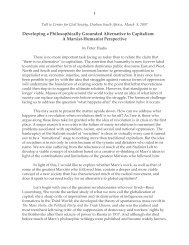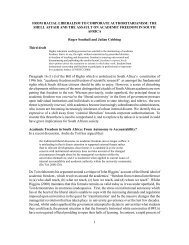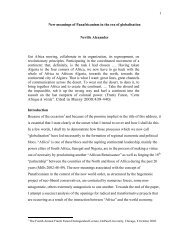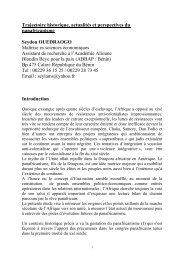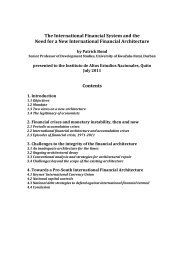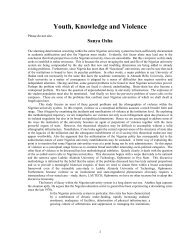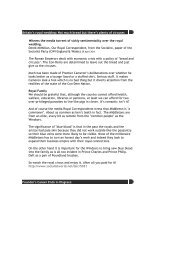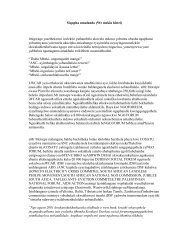The Cape of Good Dope? - Centre for Civil Society - University of ...
The Cape of Good Dope? - Centre for Civil Society - University of ...
The Cape of Good Dope? - Centre for Civil Society - University of ...
Create successful ePaper yourself
Turn your PDF publications into a flip-book with our unique Google optimized e-Paper software.
are fought on the domestic front rather than on the ramparts <strong>of</strong> the <strong>for</strong>tress. <strong>The</strong><br />
declared fraternity reveals its fratricidal face’ (Bauman 2002:97).<br />
<strong>The</strong> State<br />
Among their most notable accomplishments, the criminological<br />
positivists succeeded in what seemed impossible. <strong>The</strong>y separated the<br />
workings <strong>of</strong> crime from the workings and theory <strong>of</strong> the state. (Matza<br />
1969:143)<br />
Inscribed in Pagad’s repertoire was the public indictment <strong>of</strong> police collaborating with<br />
gangsters. This earned it the wrath <strong>of</strong> the police attached to ‘local’ police stations.<br />
Pagad clearly was not a ‘neighbourhood watch’ working in tandem with the police.<br />
Both began to work against each other. <strong>The</strong> police accused Pagad <strong>of</strong> undermining their<br />
credibility and ‘taking the law into their own hands’; Pagad countered that the police<br />
were infested with rogue policemen and were intent on ‘criminalising’ Pagad. This<br />
‘distance’ was exacerbated by Pagad’s refusal to work through Community Policing<br />
Forums (CPFs). <strong>The</strong> CPFs were an <strong>of</strong>fshoot <strong>of</strong> the neighbourhood watches, given<br />
statutory recognition but no real power. <strong>The</strong>y consisted <strong>of</strong> community members and<br />
police. <strong>The</strong> CPFs were ‘corporatist’ structures at a local community level, and while<br />
creating an interface between the police and community, seemed to work against mass<br />
participation and mobilisation because all issues had to be ‘mediated’. <strong>The</strong> issue <strong>of</strong><br />
CPFs could not be separated from a perception that many <strong>of</strong> the police were implicated<br />
in having relationships with the gangsters and were generally seen as <strong>of</strong>ten acting like<br />
gangsters on the Flats.<br />
Community members faced intimidation if they spoke out, with gangsters <strong>of</strong>ten being<br />
fed in<strong>for</strong>mation on what was said at meetings. An investigation by the Public<br />
Protector’s <strong>of</strong>fice headed by Selby Baqwa in 1998 ‘found that senior <strong>Cape</strong> Town<br />
police effectively shielded members <strong>of</strong> the notorious Hard Livings gang from the rule<br />
<strong>of</strong> law <strong>for</strong> years . . . Advocate St<strong>of</strong>fel Fourie, who worked on the investigation <strong>for</strong><br />
Baqwa, says the police work was generally “<strong>of</strong> very poor standard . . . Most <strong>of</strong> the<br />
residents live in fear and would not dare lodge any complaints . . . People who have<br />
lodged complaints with the police are mostly intimidated, and in some cases even<br />
assaulted or murdered”’ (Mail & Guardian, 6 March 1998).<br />
Evidence kept piling up <strong>of</strong> police complicity in making dockets disappear: ‘For<br />
example, in May 1999, 28s gang boss and member <strong>of</strong> the drug cartel <strong>The</strong> Firm, Ernest<br />
“Lastig” Solomons, walked free on murder and kidnap charges. <strong>The</strong> <strong>Cape</strong> High Court<br />
heard how the investigating <strong>of</strong>ficer, Superintendent Gert Ellis, carried the Solomons<br />
docket, which was tampered with, in his briefcase <strong>for</strong> eight years. <strong>The</strong> investigator was<br />
suspended months after Judge Jeanette Traverso described him as “the least credible<br />
witness I have come across in my 30-year career”’ (<strong>Cape</strong> Argus, 8 June 2001).<br />
As Kinnes has indicated, in some cases gangsters and drug dealers joined the CPFs!<br />
<strong>The</strong> abuse <strong>of</strong> power within legitimate structures by illegitimate actors<br />
was nowhere more obvious than in the Bishop Lavis CPF. During the<br />
late 1990s, gangsters infiltrated the CPF and set themselves up as<br />
community workers, thereby gaining access to police strategies. After it<br />
11



